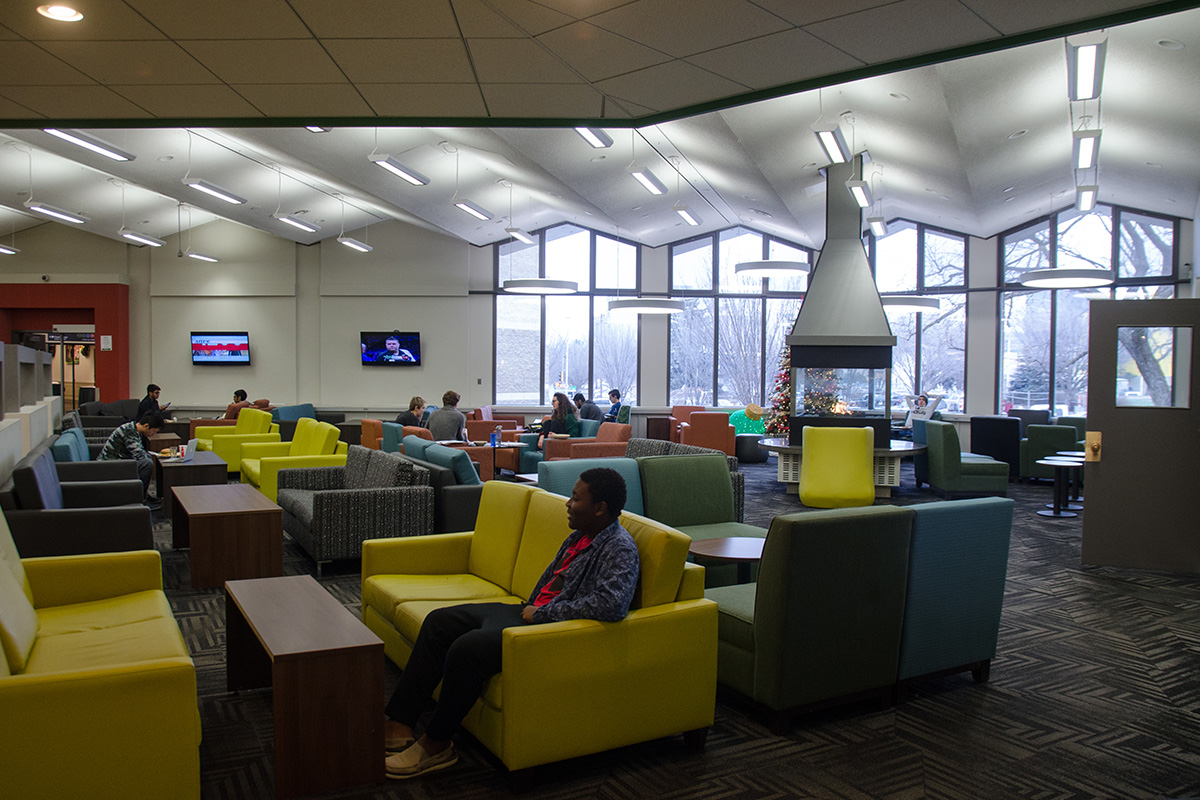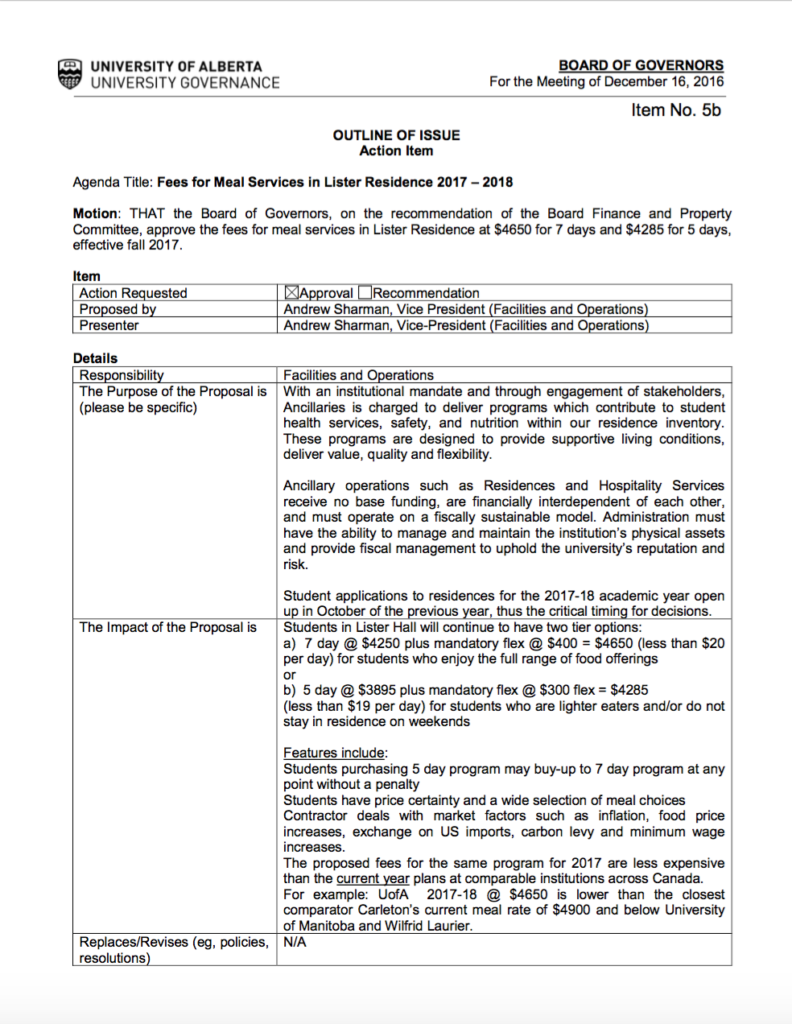Lister meal plan #2 voted down at Board of Governors
 Zoe Joyall
Zoe JoyallOnce again, it is unclear what type or price of meal plan Lister’s residents will have in 2017-18.
A tie vote at the December 16 Board of Governors meeting knocked down a proposal for Listerites to pay either $4,650 or $4,285 towards an all-you-can-eat meal plan. The meal plan proposal restricted next year’s students to eating in Lister’s dining hall (with $300 and $400 of “flex dollars” to be used across campus) with the promise that food quality will increase.
Seven board members were in favour, while seven were opposed. The board did not put forward an alternative meal plan, but university administration said another would be brought forward in the future.
The meal plan came to the board after passing at a “special” Board Finance and Property Committee meeting last week. The proposal had been sent to committee members 22 hours before the meeting itself.
Read about last week’s proposal: Board of Governors to vote on all-you-can-eat Lister meal plan.
Though more expensive than Lister’s current $3,873 and $4,554 declining balance meal plans, university Vice-President (Facilities and Operations) Andrew Sharman said the all-you-can-eat plans would guarantee the university enough revenue to upgrade the quality of Lister food and build a hot meal facility in the Central Academic Building by Fall 2018.
“I will admit, (the plan’s) not perfect, but it’s the best that we can achieve,” he said. “It addresses the longstanding criticisms about quality, variety, nutritional balance, quantity, and hours. We’re trying to address flexibility while providing a fiscally viable plan.”

Ancillary Services, the university body that facilitates residence meal plans, operates without university or government funding, meaning it must balance its own costs with revenues. The body can’t upgrade the quality of Lister dining hall food unless it receives more funding — which must be gathered from students through meal plans, Sharman said. He added that switching to a more expensive all-you-can-eat meal plan would bring Ancillary Services out of a deficit situation by 2021-22, as it’s been in one for four of the past five years.
Ancillary Services is going to face more costs in the future with Alberta’s new carbon tax and rising minimum wage.
Board members were divided over whether the proposed meal plan was a sufficient compromise, and whether more work was needed to meet student needs. Administrators, including Sharman and President David Turpin, said the meal plan needed to move forward on December 16 to ensure next year’s residence applicants know what they would be paying next year.
University board members debated for roughly an hour about the implementation a new meal plan. In the end, the vote came down to Board Chair Michael Phair, who voted against the meal plan at the committee level.
“I am very concerned that we are trying to make a decision when there is so much disagreement among board members,” Phair said. “There isn’t really a successful compromise. I really appreciate the administration (and the funding situation), and I also appreciate students and the certainty they want in accessing food.”
Those in favour…
Turpin prefaced the meal plan discussion by stating the university was “in a box” when it came to food, since Ancillary Services has to fund itself. Sharman furthered that the proposed plan wasn’t “the best, but was the closest (the university) could get” to optimal flexibility and quality.
“This plan has been five years in gestation,” Sharman said. “Over that period, we’ve been looking to address criticisms. We’ve had multiple engagements, consultations, and discussions with students and student leaders over this time.”
The university executives stressed that the meal plan needs to be decided soon, as next year’s students will soon be applying for residence and said the cost of the 2017-18 meal plan should be advertised.
Director of Hospitality Services, Dolores March, said the program offers more flexibility for students, and would lead to less students having to top up their plans. About a third of Lister residents top their meal plans up, according to Dining Services.
“This plan is designed for first year students who are away from home for the first time,” March said. “This is a huge transition for them and worrying about budgeting and buying food is something they shouldn’t have to do.”
Board member Shenaz Jeraj said the meal plan was “much better” than was she’d previously seen being brought forward to the board.
“We have to look at how we balance this,” Jeraj said. “We do want to support students, and I do agree that food has to improve with services, but (the meal plan proposal) is a much better than other plans I’ve seen before.”
Those opposed…
Students’ Union President Fahim Rahman said that student consultation for the meal plan was insufficient. Because the proposal was introduced in a meeting with the SU on December 9, passed at the committee level on December 13, and tabled at the board on December 16, the SU had no time to gather feedback from students.
He also said he didn’t consider the new plan flexible, as it only allowed students between $300 and $400 to spend at campus vendors. The current plans allow students to spend as much as they want across all vendors on campus. He proposed that the university continue with the current plan for another year, and work with the SU to find a plan that’s more sustainable for the university in the long term.
“The primary flexibility that students get right now is being able to spend on over 20 locations on campus,” Rahman said. “(The proposal) only allows students to spend $400 at these locations. If you’re studying in the Engineering Teaching and Learning Complex, you’re probably going to be spending money out of their own pockets.”
The SU’s Board of Governors representative, Colin Champagne, added that many students, such as those in engineering, often have long, sometimes volatile schedules that don’t afford time for returning to the dining hall between classes and labs.
“(This proposal) has no dietary statements, no timeline statements,” Champagne said. “This motion is limited uniquely to price. So we have no guarantee that those things will be implemented.”
Had the plan passed, students would be able pick up hot lunches (ordered over the Hangry app the night before) from CAB in 2017-18, but these lunches would be prepared in the Lister dining hall. By 2018, an actual food preparation facility would be installed in CAB and students under the meal plan would have direct access to hot food. Public board representatives James Heelan and Raymond Muzyka voted against the meal plan, arguing that students next year should have access to a hot food facility in CAB.
And though university executives said the meal plan needed to be decided on December 16 for potential Listerites to know what they’ll be paying for food, Heelan didn’t see the meal plan as something that needed to be decided on immediately. He argued that current declining balance meal plan should be advertised, and if the board finds an all-you-can-eat model that resonates with students, a motion could be voted on over email or in the next meeting in March.
“There needs to be more in CAB,” Heelan said. “There needs to be full-service. Or something better than ordering the night before … I am sympathetic to the concern that we’re running into the time that students are accepting offers, but I do think that this is something we should address in March.”





Congratulations to the Board. They did their job. They did not allow the university administration to ram through a flawed ‘plan’, which was primarily aimed at raising prices, rather than providing a flexible, useful and healthy meal plan for the benefit of students.